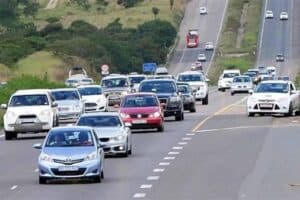And, starting this week, historical debts will start to lapse, making the roads agency's balance book even worse.

The Organisation Undoing Tax Abuse (Outa) has produced a graphic that starkly illustrates the ongoing failure of e-tolls.
The NGO, which started life as the Opposition to Urban Tolling Alliance, points out that in April 2012, the SA National Roads Agency (Sanral) said in court they would achieve 93% compliance levels and generate average income levels of more than R3 billion per annum.
BusinessTech reports that Sanral intended to use roughly two-thirds of that money to settle bonds and one-third (over R1 billion) to pay for the collection process using the complicated technology of the highway gantries that is managed by Kapsch TrafficCom.

How far Sanral’s financial projections have fallen from reality over the past three years. Graphic: Outa
“Our research shows that around the world, these electronic toll payment schemes require compliance levels well upward of 80% in order to succeed,” BusinessTech quoted Outa chairperson Wayne Duvenage as saying, but this is far from the case in South Africa.
“At best and only after a multimillion-rand marketing campaign that threatened motorists with criminal records, the scheme was able to achieve around 40% compliance levels at R120 million per month by mid 2014. Today, that level has dropped to below 18% and around R60 million per month.”
From this week, Sanral’s e-toll debt will begin to prescribe (lapse) at a rate of about R10 million per day, added Duvenage, meaning Sanral will be forced to write off its debt – “which has been falsely reported as a collectable asset in their financial statements”, Outa said.
To make things worse, the Gauteng car pool has grown by 1 million vehicles to 4.2 million since 2009. The car pool for the whole of SA has grown to 10.7 million from 4.9 million in 1994, and is expected to reach 16 million in 2030.
The e-tolls boycott has hit Sanral’s funding for planned route developments that would alleviate congestion on the Joburg-Pretoria highway. These routes include the PW9 as a parallel route to the Ben Schoeman highway; a ring road around Pretoria to ease traffic congestion in the east of the city and provide better access to the western suburbs; a route connecting Soweto to Midrand; and the planned PWV14 route intended to route traffic away from the often-gridlocked Gillooly’s interchange to the east of Johannesburg.
Sanral says these projects have been delayed by the e-tolls boycott, which has hit its revenue collection. According to figures reported to parliament, 2.9 million Gauteng freeway users have outstanding debts to Sanral. The total outstanding debt is R7.2 billion, according to the 2016 annual report.
Then there is the practical difficulty of collecting outstanding debts of close to R7 billion, which Gauteng motorists could not sustain without serious damage to the provincial economy. Sanral has issued more than 6 000 summonses in an effort to collect outstanding debts, and Alex van Niekerk, Sanral’s project manager for GFIP, says further summons will be issued.
Despite the Prescription Act, Sanral will have difficulty claiming debts older than three years. It might attempt to criminalise defaulters through the Administrative Adjudication of Road Traffic Offences (Aarto) Act, but this will almost certainly be challenged in the Constitutional Court.
Outa has challenged Sanral’s refusal to write off large parts of its overdue debt, some of which is nearly three years old and therefore well past the generally accepted accounting standards for debt write-off (which should be expensed through the income statement). Instead, Sanral is counting this debt as an asset on its balance sheet, which was signed off by the Auditor-General.
Sanral offered motorists a 60% discount on outstanding bills, but the response to this was miserable. Outa reckons collections are running at between R50 million and R70 million a month, which is a fraction of where they need to be.
In practical terms, e-toll boycotts have shifted Sanral’s funding burden back to government, which provides guarantees allowing the state-owned company to raise borrowings on the bond market.
Given the mess the e-tolls boycott has generated, would it not have been better to impose a 9c a litre fuel levy as Outa suggested? Had Sanral done this, the Gauteng Freeways would theoretically have been paid off by now.
Van Niekerk says Sanral is bound by government’s commitment to the user-pay principle (ie, tolling) and there are costs associated with ring-fencing a portion of the fuel levy for a particular highway project.
“Given all the routes that have to be built around the country, we would end up with a multitude of ring-fenced portions of the fuel levy, which would render it uncontrollable.”
National Treasury is in any event against ring-fencing, while a 9c a litre fuel levy would not provide for future maintenance, says van Niekerk. Additionally, motorists elsewhere in the country may object to paying for Gauteng roads they do not frequently use.
Duvenage replies: “Gauteng generates close of 40% of the GDP of SA, and is paying for roads elsewhere in the country through its tax contributions. The argument that a fuel levy would prejudice motorists elsewhere does not hold water.”
Duvenage says there is almost no chance of Sanral recovering its outstanding debts, as there are insurmountable legal and practical aspects to the recovery of its debt. A high court legal test case between Outa and Sanral is looming, but the matter is unlikely to be resolved any time soon.
Van Niekerk says similar tolling programmes have succeeded in other developing countries, and cites Chile as an example, where 93% of motorists pay their bills.
Additional reporting by Moneyweb






